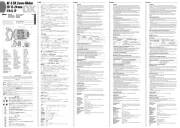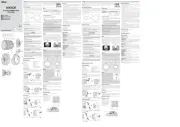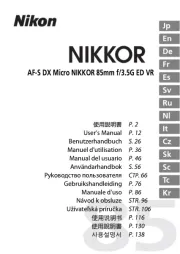Nikon Nikkor 28mm f/2.8 Handleiding
Bekijk gratis de handleiding van Nikon Nikkor 28mm f/2.8 (3 pagina’s), behorend tot de categorie Lens. Deze gids werd als nuttig beoordeeld door 66 mensen en kreeg gemiddeld 4.7 sterren uit 33.5 reviews. Heb je een vraag over Nikon Nikkor 28mm f/2.8 of wil je andere gebruikers van dit product iets vragen? Stel een vraag
Pagina 1/3

日本語
English
Deutsch
Français
Nikkor
28mm
f/2.8
使用説明書
Instruction Manual
Bedienungsanleitung
Manuel d'utilisation
Manual de instrucciones
付属アクセサリー
52mmスプリング式前キャップ
裏ぶたLF-1
Standard accessories
Accessoires standard
Accesorios estándar
Serienmäßiges Zubehör
52mm snap-on front lens cap
Rear lens cap LF-1
Bouchon avant d'objectif
ø52mm à encliquetage
Bouchon arrière d’objectif LF-1
Tapa frontal de presión a
52mm
Tapa trasero LF-1
Aufsteckbarer Frontdeckel
52mmø
Hinterer Objektivdackel LF-1
使用説明書が紛失または損傷した場合は、当社サービス機関に新しい使用説明書をお求めください(有償)。
No reproduction in any form of this manual,
in whole or in part (except for brief quotation in
critical articles or reviews), may be made without
written authorization from NIKON CORPORATION.
FUJI BLDG., 2-3 MARUNOUCHI 3-CHOME, CHIYODA-KU,
TOKYO 100-8331, JAPAN
Printed in Japan ●HB7L06(70)
8MNJA112-06▲
⑥ファインダー内直読用絞り目盛
Aperture
-
direct
-
readoutscale
Blandenskalafür Sucher-
Direktablesung
Lecture directe du diaphragme
Escala de lectura directa de la
abertura
④
EE連動ガイド
EEservocouplingpost
Kupplungsstift für automatische
Blendensteuerung
Index de servocommande
diaphragme
Borne del servo acoplador EE
②
レンズプロテクター
Rearelementprotectors
Hinterlinsenschutz
Protecteurs de l'élément arrière
Protectores del elemento trasero
①
露出計連動ガイド
Metercouplingridge
Steuerkurve
Index de couplage photométrique
Protuberancia de acoplamiento al
exposímetro
③
開放F値連動ガイド
Apertureindexingpost
Anschlag für Blendenkupplung
Coupleur de l'ouverture
Pivote indicador de abertura de
diafragma
⑤露出計運動爪
Metercouplingshoe
Blendenmitnehmer
Fourchette de couplage du
posemètre
Zapata de acoplamiento al
exposmetro
Español
レンズ取り扱い上のご注意
警告
使用禁止
シンナーやベンジンを使用しないこ
と
火災や健康障害の原因となります。
製品を破損します。
仕様
焦 点 距 離
最 大 口 径 比
レ ン ズ 構 成
画角
距離目盛(併記)
絞 り 目 盛
絞 り 方 式
測 光 方 式
マ ウ ン ト
アタッチメントサイズ
フ ィ ル タ ー
大 き さ
重 量(重さ)
:28mm
:1:2.8
:8群8枚
:74°
:∞〜0.2m、1.7ft(併記)
:
2.8〜22ファインダー内表示用絞り目盛併記
:自動絞り
:開放測光
:ニコンFマウント
:52mm(P=0.75mm)
:52mmねじ込み式
:
約63mm(最大径)×44.5mm(長さ:バヨネット基準
面からレンズ先端まで)、全長約53mm
:約250g
はじめに
このたびは、ニッコールレンズをお買いあげいただきありがとうござ
います。
このレンズは、ニコンFマウントのカメラボディに装着することができ
ます。また、 と連動して開放測光TTL露出計(F-401カメラを除く)
が行えます。
レンズ構成は8群8枚で、レトロフォーカスタイプの広角レンズです。
諸収差がよく補正され、像面の平坦性も優れているため、開放絞りで
もコントラストの良い、シャープな像を結びます。また、多層膜コー
ティングを有効に採用していますので。ゴースト、フレアーが少なく
コントラストの良い画像が得られます。カラー撮影における色調も、
他のニッコールレンズ同様優れた色再現を示します。
風景写真はもとより、比較的暗い室内での撮影、建築写真、スナップ、
遠近感誇張を目的とした撮影、旅行中の記録写真などに最適です。更
に近距離補正方式を採用しているため、近写性能にも優れているなど
用途の広いレンズです。
注記
●AI方式で露出計連動レバーがハネ上げ式のカメラボディにこのレン
ズを取り付ける場合は、カメラボディの露出計連動レバーが正しい
位置にあるか確認して取り付けてください。また、従来のTTL露出
計付きカメラボディに取り付ける場合は、露出計と連動させるため
に必ず開放F値のセットを行ってください。(いずれの場合も詳細
はカメラボディの使用説明書をご参照ください。)
●このレンズとF-401カメラとの組み合わせでは、カメラの露出計
は使用できません。(表示も出ません)
ファインダースクリーンとの組み合わせ(裏面参照)
ニコンF6、F5、F4およびF3シリーズカメラボディには多種類のファ
インダースクリーンがあり、レンズのタイプや撮影条件に合わせて最
適なものを選ぶことができます。このレンズに適したファインダース
クリーンは裏の表のとおりです。(なお、ご使用に際しては必ず各カ
メラボディの使用説明書を併わせてご参照ください。)
●レンズの清掃は、ホコリを拭う程度にしてください。万一指紋や汗
がついたときは、柔らかい清潔な木綿の布に市販のレンズクリーナ
ーを少量湿らせ、中心から外側へ渦巻状に、拭きムラ、拭き残りの
ないように注意しながら軽く拭きます。
●レンズ表面の汚れや傷を防ぐために、NCフィルターの使用をおす
すめします。レンズの保護には、フードも役立ちます。
●レンズをご使用にならないときは、傷や汚れ防止のためレンズの前
後に必ず付属のキャップをしておいてください。
●レンズを水に濡らした場合は、当社サービス機関に点検修理を依頼
してください。部品がサビついたりして故障の原因となりますので
ご注意ください。
●長期間レンズをお使いにならないときや保管の際は、カビまたはサ
ビを防ぐため、高温多湿の所や直射日光のあたる所、またナフタリ
ンや樟脳のある所は避けて、風通しのよい場所に保管してください。
●このレンズは、外観の一部には強化プラスチックを使用しておりま
すが、極端に温度が高くなると変形する場合があります。ストーブ
の前等、高熱となる場所に置くことは避けてください。
アクセサリー
別売りアクセサリー
52mmねじ込み式フィルター
52mmねじ込みフードHN-2
ソフトケースCL-0815
Consisting of 8 elements in 8 groups, this retrofocus
wideangle lens is lightweight and compactly designed.
Spherical and coma aberrations are well corrected to
ensure uniformly sharp images of high contrast over
the entire lm plane even at full aperture. Adopting
the Nikon’s Close-Renge Correction System, this lens
also oers high performance enen in close-up shooting.
In addition, the application of multilayer anti-reection
coating (known as Nikon Integrated Coating, or NIC)
on air-to-glass surfaces minimizes are and ghost,
making for improved contrast and netural color
rendition. The lens oers “automatic maximum apertre
indexing
” (Al) with suitably equipped cameras (except
F-401/N4004*), via the meter coupling rigde provided.
The ridge and the auto diaphragm function together
permit full apertre exposure measurement ; the lens
is also tted with a meter coupling shoe to permit the
same oeration with Nikon cameras which lack the Al
facility. An “aperture-direct-readout” scale is engraved
on the lens to allow direct reading of the aperture
setting in suitably eqipped camera nders. The fast
lens speed of f/2.8 makes picture framing, composing
and focusing aesy. The lens is especially suitable
for architectural photography and other applications
where special eects are desired.
*The Nikon N4004 is sold exclusively in the U.S.A.
Important!
•
When mounting the lens on a camera body with a
meter coupling lever (Al type), make sure that the lever
is correctly positioned; when mounting on a camera
body without this lever (non-Al type), “manual”
maximum aperture indexing is required. In both
cases, refer to the camera's instruction manual.
• When the lens is used with the Nikon F-401/N4004,
the camera meter coupling function does not operate
and the exposure indecator LEDs do not appear.
Recommended Focusing Screens
(see the reverse)
Verious interchangeable focusing screens are available
for Nikon F6-,F5-,F4- and F3-series cameras to suit
any type of lens or picture-taking situation. Those wihch
are recommended for use with this lens are listed in the
table (see the reverse). For details, also refer to the
specic camera's instruction manual.
Lens Care
•
Clean lens surface with a blower brush. To remove
dirt and smudges, use a soft, clean cotton cloth or
lens tissue moistened with lens cleaner (separately
available). Wipe in ca circular motion from center to
outer edge, taking care not to leave traces and not to
touch the other lens parts.
•
To protect the lens surface from dirt or damage,
the use of an NC filter is recommended at all times.
The lens hood also helps to protect the lens.
•
To protect the lens surface from dirt or demage,
replace both the front and rear caps whenever the lens
is not in use.
•
Do not splash water on the lens or drop it in the water
because this will cause it to rust and malfunction.
•
If you will not use the lens for a long time, protect it
from rust and mold by storing it in a cool, dry place.
Also, do not store in direct sunlight, and keep it away
from naphthalene or camphor.
•
Reinforced plastic is used for some parts of the lens
exterior; to avoid damage, never leave the lens in an
excessively hot place.
Optional Accessories
Specifications
52mm screw-in filters
52mm screw-in
lens hood
HN-2
Flexible lens pouch CL-0815
Focal length :
28mm
Maximum aperture :
f/2,8
Lens construction :
8 elements in 8 groups
Picture angle :
74°
Distance scale :
Graduated in meters and feet from 0.2m
(0.7ft) to innity ( )∞
Aperture scale :
f/2,8–f/22 on both standard and
aperture-direct-readout scales
Diaphragm :
Fully automatic
Exposure measurement :
Via full aperture method, meter coupling
ridge provided for Al cameras and meter
coupling shoe for non-Al cameras
Mount :
Nikon bayonet mount
Attachment size :
52mm (P=0.75mm)
Filters :
52mm screw-in
Dimensions :
Approx. 63mmø x 44.5mm extension from
ange; approx. 53mm long (over all)
Weight :
Approx. 250g
Compact et léger, ce grand-angulaire du type rétrofoyer
bénéficie du traitement multicouches exclusif Nikon
(NIC), assurant un contraste élevé de l’image sur
l’ensemble du champ, une délité dans la restitution
chromatique et une réduction des réexions parasites.
La correction des aberrations de sphéricité et de coma
garantit une excellente définition même à pleine
ouverture. Adoptant le dispositif Nikon de correction
pour prises de vues rapprochées, cet objectif est très
performant même pour les gros plans. Cadrage,
composition et mise au point sont grandement facilités
par l’ouverture f/2,8. Cet objectif est tout spécialement
adapté aux photographies de paysage et d’architecture.
L’objectif est doté d’un index de couplage
photométrique interne qui informe automatiquement
le posemètre de l’ouverture maximale de l’objectif
utilisé, dans le cas de boîtiers bénéciant de ce type
de couplage (Al) (sauf dans le cas du F-401).
Grâce à cet index de couplage et à la présélection
automatique du diaphragme, le posemètre peut
analyser la lumière à pleine ouverture. Une
fourchette de couplage photométrique (externe)
permet la mesure à pleine ouverture avec les boîtiers
Nikon qui ne sont pas dotés du système Al.
Important!
• Lorsque l'objectif est monté sur un bîtier ne
bénéciant pas du système Al, le couplage
photométrique doit obligatoirement être réalisé
manuellement (se reporter au manuel d'utilisation du
boîtier pour plus de détails).
•
Quand l’objectif est utilisé avec le boîter NikonF-401,
la fonction de couplage photométrique n’opère pas,
et l’ indiateur d’exposition DEL n’apparaît pas.
Verres de visée recommandés (Voir la table.)
Divers verres de visée interchangeables sont disponibles
pour les appareils Nikon des séries F6,F5,F4 et F3 pour
convenir à tout type de situation d'objectif ou de prise de
vue. Ceux qui sont recommandés pour l'utilisation avec
cat objectif sont inscrits dans la liste du tableau (voir le
verso). Pour plus de détails, se référer aussi au mode
d'emploi de l'appareil spécique.
Soins à apporter à votre objectif
• Nettoyer la surface de la lentille avec une brosse
souante. Pour éliminer la saleté et les taches, utiliser
un chion en coton doux et propre ou un tissu pour
lentille imbibé de produit de nettoyage pour lentilles
(en vente séparée). Essuyer dans un mouvement
circulaire du centre vers l'extérieur, en prenant soin
de ne pas laisser de traces et de ne pas toucher les
autres parties de l'objectif.
• Laisser un ltre NC monté en permanence constitue
une bonne protection de la lentille avant contre
la poussière et les chocs. Le bouchon avant est
également une protection ecace de la lentille avant.
• Pour protéger la surface de l'objectif contre la saleté
et les dommages, rebouchez l'avant et l'arrière
de votre objectif lorsque vous ne vous servez pas
de votre appareil.
• Ne pas éclabousser d'eau sur l'objectif ni le faire
tomber dans l'eau car ceci provoquerait de la rouille
et un mauvais fonctionnement.
• Si vous n'utilisez pas l'objectif pendant une longue
période de temps, protégez-le contre la rouille et
l'humidité en le rangeant dans un endroit sec et frais.
Egalement ne le rangez pas en plein soleil at tenez-le
éloigné de la naphtaline ou du camphre.
• Certaines pièces extérieures de l'objectif sont en
plastique renforcé; pour éviter toute détérioration,
ne pas ranger l'objectif dans un endroit excessivement
chaud.
Accessoires optionnels Caractéristiques
Filtres vissants ø52mm
Parasoleil vissants ø52mm
HN-2
Etui rigide CL-0815
Focale : 28mm
Ouverture maximale : f/2,8
Construction optique : 8 lentilles en 8 groupes
Champ angulaire : 74°
Distance minimale d'approche
:
Graduée en mètres et en pieds,de 0,2m
(0,7ft) à l'inni ()
Gamme d'ouverture : f/2.8 à f/22
Diaphragme :
Auto
Analysé de lumière :
A pleine ouverture per couplage
sensitométrique
Monture : Baïonnete Nikon
Diamètre frontal : 52mm (P=0,75nn)
Diamètre de filtre : 52mm à vis
Dimensions :
Env. 63mmø x 44,5mm extension de
l’embase; env. 53mm longuer (totale)
Doids :
Env. 250g
Accesorios opcionales Especificaciones
Filtros de rosca de 52mm
Parasol de rosca 52mm
HN-2
Bolsa exible CL-0815
Longitud focal
: 28mm
Abertura máxima
: f/2,8
Construcción del objetivo
: 8 elementos en 8 groupos
Angulo fotográfico
: 74°
Escala de distancia
:
Graduada en metros y pies: desde 0.2m
(0,7 pie) hasta el infinito ()
Escala de abertura
:
f/2,8–f/22 tanto en la escala normal y la
de lectura directa de la abertura
Diafragma
: Totalmente automático
Medición de la exposición
:
Por medio del método a plena abertura;
cumbrera de acoplamiento al exposimetro
provista para cámaras Al y zapata de
acoplamiento al exposímetro para c
á
maras
sin Al
Montura
: A bayoneta Nikon
Medida de enlazamiento : 52mm (P=0,75mm)
Filtros
: De rosca, 52mm
Dimensiones
: Aprox, 63mmø x 44,5mm desde la
pastaña de montaje; aprox. 53mm largo
(total)
Paso
: Aprox. 250g
Consistiendo de 8 elementos en 8 grupos, este objectivo
gran nagular de diseño retrofobo es ligero y compacto.
Debidamente corregido contra las aberraciones
esféricas, para asegurar imágenes nítidas de gran
contraste en la palícula, aun en la abertura máxima.
Si se adopta el Sistema de Enfoque interno de Nikon,
este objetivo puede ofrecer un alto rendimiento aun en
fotografías de primer plano. Además la aplicación del
recubrimiento de capas múltiples anti-reejante
conocido como el recubrimiento integral Nikon (o NIC)
en todas las supercies exteriores, reduce
considerablemente los reejos y las imágenes
fantasmas, para obtener un mejor contraste y mejores
tonos natrales en película de color. El objetivo ofrece
“registro automático de la abertura máxima” (Al) con
las cámaras convenientemente equipadas, gracias a
la protuberancia de acoplamiento al exposímentro
provista (excepto F-401/N4004*). La cumbrera y el
diafragma automático funcionan juntos para permitir la
medición de la exposición a plena abertura;
l
os objetivos están provistos con una zapata de
acoplamiento al exposímetro para permitir la misma
operación con cámaras Nikon que no cuentan con
la facilidad A. Para permitir la lectura directa de
la abertura elegida en los visores de cámaras
convenientemente eqipadas hay grabada en los
objetivos una escala de “lectura directa de la abertura.”
La luminosidad f/2,8 hace posible el componer,
encuadrar y enfocar muy fácilmente. Este objetivo es
especialmente recomendable para fotografía
arquitectónica y algunas otras aplicaciónes en donde
se desean efectos espediales
*
La Nikon N4004 es vendida exclusivamente en EE.UU.
Importante!
•
Cuando monta el objetivo en el cuerpo de una cámara
con palanca para el acoplamiento del exposimetro (del
tipo Al), asegúrese que esta palanca esté colocada
correctamente. Cuando lo monte en el cuerpo de una
cámara que no tenga esta palanca (del tipo sin Al),
se requiere el ajuste“manual”de la abertura máxima.
En ambos casos, véase el manual de instrucciones de
la cámara.
•
Cuando se utilice el objetivo con la Nikon F-401/
N4004, no operará la función de acoplamiento del
exposímentro de la cámara y no aparecerán los
indicadores LED de exposición.
Pantallas de enfoque recomendadas
(Vea la table.)
Existan varias pantallas de enfoque intercambiables para
las cámaras de la serie F6,F5,F4 y F3 de Nikon aptas para
todo tipo de objetivo o situación fotográca.
Las pantallas que se recomiendan con este objetivo
aparecen en la lista de la tabla. Para más detalles, vea
asimismo el manual de instrucciones de la cámara de que
se trate.
Cuidado del objetivo
• La superficie del objetivo deberá limpiarse con cepillo
soplador. Para eliminar la suciedad y las manchas,
se utilizará un paño de algodón suave y limpio o papel
de seda para lente humedecido con limpiador de lente
(disponible por separado). Limpiar frotando
circularmente desde el centro hacia el borde exterior,
tomando la precaución de no dejar trazas y sin tocar
las demás partes del objetivo.
• Para proteger la supercie del objetivo contra el
polvo o algún daño, se recomienda el uso permanente
del ltro NC. El parasol también servirá como
protección del objetivo.
• Para proteger la supercie de la lente contra la
suciendad el daño, colocar las tapas delantera
y trasera mientras no se use el objetivo.
•
Que no salte ague sobre el objetivo ni lo deje caer en
el ague pues esto hará que se oxide y que functione
mal.
•
Cuando no se utilice el objetivo durante un período
prolongado, deberá protegerse contra la oxidación y el
moho, guardando en un lugar fresco y seco. Además,
no deberá exponerse a la luz solar directa y
mantenerse alejado de la naftalina o el alcanfor.
•
Algunas de las partes exteriores del objetivo utilizan
plástico reforzado; para evitar avería, no debe dejarse
el objetivo en lugares excesivamente calientes.
Dieses Retrofokus-Weitwinkelobjektiv mit sieben
einzelstehenden Linsen besticht durch seine leichte und
kompakte Konstruktion. Die weitgehende Korrektoin der
sphärischen Bildfehler und Koma garantiert
gleichmäßige Schärfe und hohen Kontrast über das
gestamte Bildfeld selbst bei voller Önung. Durch
Anwendung von Nikons Nahbereich-korrektur-System
liefert dieses Objektiv auch ausgezeichnete Bilder selbst
bei Nahaufnahmen. Eine weitere Kontraststeigerung
und Verbesserung der Farbwiedergabe konnte durch
NIC-Mehrschichtenvergütung (Nikon Integrated Coating)
auf den Glas-Luft-Flächen erzielt werden, die Reexe
und Streulicht weitgehend ausschaltet. Das Objektiv
bietet “Automatische maximale Blendenanzeige” (Al) bei
entsprechend ausgerüsteten Kameras (ausgenommen
F-401) über den vorgesehenen Verbindungswulst für
Belichtungsmesser. Der Wulst und die automatische
Blende arbeiten zusammen und gestatten eine
vollständige Belichtungsmessung. Das Objektiv ist auch
mit einem Verbindungsschuh für Belichtungsmesser
versehen, welcher denselben Betrieb für Nikon
Kameras, die nicht mit der Al Vorrichtung ausgestattet
sind, ermöglicht. Eine “direkte Blendenablesung” Skala
ist in das Objektiv eingraviert und ermöglicht direktes
Ablesen der Blendeneinstellung bei entsprechend
eingerichteten Kamerasuchern. Die hohe Lichtstärke
von f/2,8 begünstigt die Bildgestaltung und
Scharfeinstellung. Das Objektiv eignet sich
insbesondere für Architekturaufnahmen und zur
Erzielung besonderer Bildeekte.
Wichtig!
•
Wenn das Objektiv an ein Kameragehäuse angesetzt
wird, welches mit einem Belichtungsmesser-
Kopplungshebel ausgestattet ist (Al-Typ), ist daraut zu
achten, daß der Hebel richtig eingestellt ist. Wenn das
Objektiv an ein Kameragehäuse ohne diesen Hebel
(kein Al-Typ) angesetzt wird, ist “manuelle” Anzeige
für die größte Blende erforderlich. Lesen Sie bei
beiden Fällen in der Bedienungsanleitung für die
Kamera nach.
•
Wenn das Objektiv an einne Nikon F-401 angesetzt
wird, ist die Steuerkurve zur automatischen Eingabe
der Lichtstärke unwirksam und die Belichtungs-LEDs
im Sucher der Kamera leuchten nicht auf.
Empfohlene Einstellscheiben
(
Siehe Rückseite
)
Für Nikon Kameras der Serien F6, F5, F4 und F3 stehen
verschiedene auswechselbare Einstellscheiben zur
Verfügung, um jedem Objektiv und jeder
Aufnahmesituation gerecht zu werden. Die für dieses
Objektiv empfohlenen werden in der Tabelle aufgeführt
(siehe Rückseite). Für weitere Einzelheiten siehe auch
Bedienungsanleitung der Kamera.
Objektivpflege
• Reinigen Sie die Linsenoberäche zunächst mit
einemBlasepinsel. Benutzen Sie zur
weitergehenden Reinigung ein mit
Linsenreinigungsmittel (gesondert erhältlich)
befeuchtetes weiches und sauberes Baumwolltuch.
Wischen Sie dabei in einer größer werdenden
Kreisbewegung von innen nach außen, und achten
Sie
dabei darauf, daß Sie keine Spuren hinterlassen
oder andere Teile des Objektivs berühren.
•
Die Frontlinse des Objektivs sollte grundsätzlich
durch ein Filter NC vor Staub und Beschädigung
geschützt werden. Auch die Gegenlichtblende
bewährt sich als Frontlinsenschutz.
•
Um die Linsenoberfläche vor Schmutz oder
Beschädigung zu bewahren, stets die vordere und
hintere Schutzkappe vorn und hinten aufsetzen,
wenn das Objektiv nicht benutzt wird.
•
Schützen Sie das Objektiv unbedingt vor Wasser,
das zu Korrosion und Betriebsstörungen führt.
•
Wenn Sie das Objectiv längere Zeit unbenutzt lassen,
bewahren Sie es an einem Kühlen, trockenen Ort auf,
um Rost und Schimmelbefall zu vermeiden. Schützen
Sie das Objektiv vor direkter Sonneneinstrahlung und
vermeiden Sie die Nähe von Naphtalin und Kampfer.
•
Bestimmte äußere Bauteile des Objektivs sind aus
verstärktem Kunststoff gefertigt. Um Schäden zu
vermeiden, darf das Objektiv niemals Plätzen mit
extrem hoher Wärme ausgesetzt werden.
Zubehör
Technische Daten
Einschraubfilter 52mmø
Einschraubbare
Sonnenbelende 52mmø
HN-12
Objectivbeutel CL-0815
Brennweite :
28mm
Maximale Blende :
f/2.8
Optische Konstruktion :
8 Elements in 8 Gruppen
Bildwinkel :
74°
Distanzskala :
Kalibriert in Meter und
Fuß: 0.2m (0.7ft) bis unendlich ()
Blendenskala :
f/2,8 –f/22 auf beiden, der Standardskala
und der Skala für direkte Ablesung
Blendenart :
Automatisch
Belichtungsmessung :
Bei voller Blende; Verbindungswulst für
Belichtungsmesser ist für Al Kameras
vorgesehen und ein Verbindungsschuh für
andere Kameras
Fassung : Nikon Bajonett Fassung
Frontgewinde :
52mm (P=0.75mm)
Filter :
52mm einschraubbar
Dimensionen :
Ca. 63mmø x 44,5mm
Länge vom Flansch; Ca. 53mm
Gesamtlänge
Gewicht :
Ca. 250g

■
接写表 このレンズを各種の接写用具に取り付けて使用するときの撮影は次のようになります。
■
Fotografische Bereiche mit dem Nahaufnahme-Zubehör
■
Rapports obtenus en proxiphotographie et photomacrographie
■
Distancia de fotografiado con la lent
e de aproximación
■
■
撮影距離
Eingestellte
Entfernung
Distance de mise
au point
Distancia de
enfoque
151– 19.6
77.6–19.1
44.0–18.2
15.4–14.1
22.8 –15.1
19.2 – 15.3
15.0 – 15.5
14.4 – 17.7
14.7–17.7
–
–
14.7 – 17.7
14.7 – 17.7
85.3 – 20.0
–
–
–
–
–
–
–
19.3 – 33.0
18.3–30.5
19.3 – 33.0
18.3 – 26.6
18.3 – 26.9
18.3 – 53.3
–
1/49– 1/3.7
1/24–1/3.4
1/12–1/3.1
1/2.0–1/1.3
1/4.9 –1.9
1/3.6 – 2.0
1.8 – 2.1
1.5 – 3.0
1.7–3.0
–
–
1.7 – 3.0
1.7 – 3.0
1/27 – 1/3.9
–
–
–
–
–
–
–
3.6 – 8.6
3.3–7.7
3.6 – 8.6
3.3 – 6.3
3.3 – 6.4
3.3 – 16
–
118 x 178 – 8.8 x 13.2
56.5 x 84.7 – 8.3 x 12.4
28.4 x 42.6 – 7.4 x 11.1
4.9 x 7.4 – 3.2 x 4.8
11.8 x 17.8 – 1.3 x 1.9
8.6 x 12.9 – 1.2 x 1.8
1.3 x 2.0 – 1.1 x 1.7
1.6 x 2.4 – 0.80 x 1.2
1.4. x 2.1 – 0.80 x 1.2
–
–
1.4 x 2.1 – 0.80 x 1.2
1.4 x 2.1 – 0.80 x 1.2
64.7 x 97.0 – 9.4 x 14.1
–
–
–
–
–
–
–
0.66 x 1.0 – 0.28 x 0.42
0.74 x 1.1 – 0.31 x 0.47
0.66 x 1.0 – 0.28 x 0.42
0.74 x 1.1 – 0.38 x 0.57
0.74 x 1.1 – 0.38 x 0.56
0.74 x 1.1 – 0.15 x 0.23
–
Kリングのはじめの数値はKリング1個使用のとき、あとの数値はK1〜K5リングを連結したときのものです。
PKリングのはじめの数値はPK-11AリングまたはPK-1リング1個使用のとき、あとの数値はPK-11A〜PK-13又はPK-1〜PK-3を連結したときのものです。
スライド複写装置PS-4、PS-5のレンズ逆向き時の倍率範囲はBR-3リングを使用したときのものです。
複写装置PF-2、PF-3、PF-4はレンズ単体で使用したとき、複写台の戴物面上の撮影可能範囲を示します。
Die ersten Zahlen gelten für den Gebrauch des K1-Ringes allein. die zweiten für alle 5 Ringe zusammen.
Die ersten Zahlen gelten für den Gebrauch des PK-11A oder PK-1 Ringes allein, die zweiten für 3 Ringe (PK-11A–PK-13 oder PK-1
PK-3) zusammen.
Der Umkehrring BR-3 wird gebraucht, um das umgekehrt aufgesetzte Objectiv an den Diakopiervorsatz anzuschliessen.
Die in dieser Kolonne aufgeführten Werte entsprechen Bereichen, welche mit dem Objekt auf der Grundplatte und dem Objektiv ohne
Nahaufnahme-Zubehör ermittelt wurden.
★
★★
★ ★ ★
★★★★
★
★★
★ ★ ★
★★★★
★
★★
★ ★ ★
★★★★
★
★★
★ ★ ★
★★★★
Los primeros números son para el anillo K1 usado solo, y los segundos números para el conjunto de cinco anillos usados juntos.
Los primeros números son para el anillo PK-11A o PK-1 usado solo, y los segundos números para el conjunto de tres anillos (PK-11A–
PK-13 o PK-1–PX-3) usados juntos.
El Macro-Anillo Adaptador BR-3 se usa para connectar el objetivo montado a la inversa con el adaptador para copia de transparencias.
Les cifras aquí mostradas representan los rangos obtenidos con el sujeto sobre la pase, usando el lente sin accesorios de
acercamlento.
Les premiers chires sont pour la bague K1 employée séparément et les seconds pour les cing bagues montés ensembles.
Les premiers chires sont pour le PK-11A ou PK-1 employé séparément et les seconds pour les trois bagues (PK-11A–PK-13 ou PK-1
–PK-3) montés ensembles.
La bague d'adaptation Macro BR-3 sert à connecter l'dbjectif inversé à l'adaptateur pour reproduction de diapositives.
Ces nombres correspondent aux limites des passibilités. le sujet étant placé sur le plateau, et l'objectif étant oémuni de tout accessoire
de macrophotographie.
★
★★
★ ★ ★
★★★★
★
★★
★ ★ ★
★★★★
撮影倍率
被写界面積
Abbildungs-
maßstab
Rapport de
reproduction
Relación de
reproducción
Aufnahmefeld
Champ couvert
Campo cubierto
レンズ逆向き
Objektive in Reprostellung
Objectif en position retournée
Objetivo en la posición invertida
撮影距離
Eingestellte
Entfernung
Distance de mise
au point
Distancia de
enfoque
撮影倍率
被写界面積
Abbildungs-
maßstab
Rapport de
reproduction
Relación de
reproducción
Aufnahmefeld
Champ couvert
Campo cubierto
(cm)
レンズ正方向
Objektive in Normalstellung
Objectif en position normale
Objetivo en la posición normal
使用器具
Nahaufnahme-Zubehör
Accessoires macro
Accesorio utilizado
クローズアップレンズNo.0
Nahlinse Nr.0
Lentille additionnelle n 0°
Lente de aproximación N .0°
クローズアップレンズNo.1
クローズアップレンズNo.2
E2リング
Kリング
PKリング
ベローズアタッチメント
PB-4、PB-5
ベローズアタッチメント
PB-6
スライド複写装置PS-4、PS-5
スライド複写装置PS-6
マクロ複写スタンドPB-6M
エクステンションベローズPB-6E
複写装置PF-2、PF-3、PF-4
Nahlinse Nr.1
Lentille additionnelle n 1°
Lente de aproximación N .1°
Nahlinse Nr.2
Lentille additionnelle n 2°
Lente de aproximación N .2°
Z
wischenringe E2
Bagues E2
Anillo de la Serie E2
Z
wischenringe K
Bagues K
Anillo de la Serie K
Z
wischenringe PK
Bagues PK
Anillo de la Serie PK
Balgengerät PB-4 oder PB-5
Soufflet PB-4 ou PB-5
Fuelles PB-4 o PB-5
Balgengerät PB-6
Soufflet PB-6
Fuelles PB-6
Diakopiergerät PS-4 oder PS-5
Reporda PS-4 ou PS-5
Adaptador para la reproducción
de diapositivas PS-4 o PS-5
Diakopiergerät PS-6
Reporda PS-6
Adaptador para la reproducción
de diapositivas PS-6
Makrokopiereinrichtung PB-6M
Statif macro PB-6M
Estativo de reproducción
macro PB-6M
Zusatzbalgen PB-6E
Soufflet additionnel PB-6E
Fuelle de extensión PB-6E
Reprogerät PF-2, PF-3 oder OF-4
Statif de reproduction PF-2,
PF-3 ou PF-4
Unidad de reproducción PF-2,
PF-3 o PF-4
PNリング
Z
wischenringe PN
Bagues PN
Anillo de la Serie PN
■
Photographic range with close-up attachment
Close-up
attachment
Close-up lens No.0
Close-up lens No.1
Close-up lens No.2
E2 Ring
K Ring set
PK-series ring (s)
PN-series ring
Bellows PB-4 or PB-5
Slide Copying Adapter
PS-4 or PS-5
Slide Copying Adapter
PS-6
Macro Copy Stand
PB-6M
Bellows PB-6
Extension bellows PB-6E
Repro copy outfit PF-2,
PF-3 or PF-4
(in)
The rst values are for the K1-ring used alone and the second ones for ve rings used together.
The rst values are for the PK-1
1A or PK-1 ring used alone and the second ones for three rihgs (PK-11A – PK-13 or PK-1 – PK-3) used
together.
The Adapter Ring BR-3 is used to connect the reverse mounted lens to the copying adapter.
The gures shown here represent the ranges obtained with the subject on the baseplate, using the lens without anu close-up
attachment.
*
**
***
****
Lens in normal position
Reproduction
ratio
Reproduction
ratio Subject field Focused
distance
Subject field Focused
distance
Lens in reverse position
1/49–1/3.7
1/24–1/3.4
1/12–1/3.1
1/2.0–1/1.3
1/4.9–1.9
1/3.6–2.0
1.8–2.1
1.5–3.0
1.7–3.0
–
–
1.7–3.0
1.7–3.0
1/27–1/3.9
–
–
–
–
–
–
–
3.6 – 8.6
3.3 – 7.7
3.6 – 8.6
3.3 – 6.3
3.3 – 6.4
3.3 – 16
–
–
–
–
–
–
–
–
7.6 – 13.0
7.2 – 12.0
7.6 – 13.0
7.2 – 10.5
7.2 – 10.6
7.2 – 21.0
–
59.4 – 7.7
30.6 – 7.5
17.3 – 7.2
6.1 – 5.6
9.0 – 5.9
7.5 – 6.0
5.9 – 6.1
5.7 – 7.0
5.8 – 7.0
–
–
5.8 – 7.0
5.8 – 7.0
33.6 –7.9
46.6 x 70.0 – 3.5 x 5.2
22.2 x 33.4 – 3.3 x 4.9
11.2 x 16.8 – 2.9 x 4.4
1.9 x 2.9 – 1.3 x 1.9
4.7 x 7.0 – 0.50 x 0.75
3.4 x 5.1 – 0.48 x 0.71
0.51 x 0.77 – 0.45 x 0.68
0.63 x 0.94 – 0.31 x 0.47
0.56 x 0.84 – 0.31 x 0.47
–
–
0.56 x 0.84 –0.31 x 0.47
0.56 x 0.84 – 0.31 x 0.47
25.5 x 38.2 –3.7 x 5.6
–
–
–
–
–
–
–
0.26 x 0.39 – 0.11 x 0.17
0.29 x 0.44 – 0.12 x 0.18
0.26 x 0.39 – 0.11 x 0.17
0.29 x 0.44 – 0.15 x 0.23
0.29 x 0.44 –0.15 x 0.22
0.29 x 0.44 – 0.060 x 0.090
–
■ファインダースクリーンとの組み合わせ表
■
Table of Recommended Foucusing Screens
Tabelle der empfohlenen Einstellscheiben
Tableau des verres de visée recommandés
Tabla de pantallas de enfoque recomendadas
■
■
■
■
■
スクリーンScreen
Einstellscheibe
カメラ
Camara Kamera
Appareil Cámara
Verre Pantalla
F6
F5+DP-30
F5+DA-30
F4+DP-20
F4+DA-20
F3
EC-B A/L B C D E G1 G2 G3 G4 H1 H2 H3 H4 J K/P M R T U
(-0.3) (-0.3) (-0.3)
(+0.5)
(-
1
/
2
)(-
1
/
2
)
(-
1
/
2
)
(-
1
/
2
)(-
1
/
2
)(-
1
/
2
)
■
被写界深度表
■
Schärfentiefe-Tabelle
■
Profondeur de champ
■
Profundidad de campo
■
■
■
Depth of Field
撮影距離 被写界深度
Eingestellte
Distanz
Distance de mise au point
Distancia de enfocade
Focused
distance f/2.8 f/4 f/5.6 f/8 f/11 f/16 f/22
Depth of field Reproduction
ratio
(m)
(ft)
Schärfentiefe
Profondeur de champ
Profundidad de campo
撮影倍率
Abbildungsmaßstab
Rapport de reproduction
Relación de reproducción
0.2
0.25
0.3
0.35
0.4
0.5
0.7
1
2
∞
1/3.88
1/5.71
1/7.5
1/9.28
1/11
1/14.6
1/21.6
1/32.1
1/67
1/∞
0.199-
0.201
0.247-
0.253
0.295-
0.305
0.343-
0.357
0.390-
0.411
0.482-
0.519
0.661-
0.744
0.916-
1.10
1.66-
2.53
9-
∞
0.198-
0.202
0.245-
0.255
0.291-
0.310
0.336-
0.365
0.380-
0.422
0.466-
0.541
0.627-
0.796
0.845-
1.23
1.42-
3.45
4-
∞
0.192-
0.209
0.232-
0.273
0.269-
0.344
0.303-
0.422
0.335-
0.510
0.392-
0.723
0.487-
1.39
0.593-
4.60
0.79-
∞
1-
∞
0.194-
0.207
0.237-
0.266
0.277-
0.330
0.314-
0.399
0.350-
0.473
0.416-
0.641
0.529-
1.09
0.663-
2.26
0.94-
∞
2-
∞
0.196-
0.204
0.240-
0.261
0.283-
0.320
0.324-
0.382
0.364-
0.447
0.438-
0.588
0.571-
0.921
0.739-
1.61
1.12-
12.6
2-
∞
0.197-
0.203
0.243-
0.258
0.288-
0.314
0.331-
0.372
0.373-
0.433
0.453-
0.560
0.601-
0.847
0.794-
1.37
1.27-
5.07
3-
∞
0.198-
0.202
0.246-
0.254
0.294-
0.307
0.340-
0.361
0.386-
0.416
0.475-
0.528
0.646-
0.766
0.884-
1.16
1.55-
2.85
6-
∞
f/2,8 f/4 f/5.6 f/8 f/11 f/16 f/22
0.7
0.8
1
1.25
1.5
2
3
5
15
∞
1/4.4
1/5.5
1/7.7
1/10.4
1/13.1
1/8.4
1/29.1
1/50.4
1/156.9
1/∞
8-5/16”–
8-7/16”
9-1/2”–
8-11/16”
9-7/16”–
9-11/16”
9-3/8”–
9-3/4”
9-5/16”–
9-7/8”
9-1/4”–
9-15/16”
9-1/16”–
10-1/8”
8-5/16”–
8-7/16”
8-1/4”–
8-1/2”
8-3/16”–
8-9/16”
8-1/8”–
8-5/8”
7-15/16”–
8-7/8”
8-15/16”–
10-3/8”
10-11/16”–
1’1- 3/4”
11’–
1’1- 3/16”
11’-1/4”–
1’13/16”
11’-7/16”–
1’9/16”
11-5/8”–
1’3/8”
11-11/16”–
1’1/4”
11-13/16”–
1’3/16”
1’2-5/8”–
1’3-5/16”
1’2-1/2”–
1’3-1/2”
1’2-5/16”–
1’3-3/4”
1’2”–
1’4-1/8”
1’1-11/16”–
1’4-9/16”
1’1-1/4”–
1’5-7/16”
1’11/16”–
1’6-11/16”
1’2-1/2”–
2’9/16”
1’3-1/4”–
1’10-1/4”
1’4”–
1’8-11/16”
1’4-1/2”–
1’7-13/16”
1’4-7/8”–
1’7-1/4”
1’5-3/16”–
1’6-7/8”
1’5-7/16”–
1’6-9/16”
1’10-7/8”–
2’1–1/4”
2’9-1/4”–
3’3–1/4”
4’4-1/16”–
5’10–7/8”
10’–
30’3”
8’9”–
54’2”
1’10-7/16”–
2’1-13/16”
1’9-7/8”–
2’2-5/8”
1’9-1/16”–
2’4”
1’8-3/16”–
2’5-15/16”
1’6-7/8”–
2’9-15/16”
1’5-9/16”–
3’4-11/16”
1’10-1/4”–
10’1/4”
2’11/16”–
6’
2’3-5/16”–
4’6-3/8”
2’5-3/16”–
3’11-9/16”
2’6-7/8”–
3’7-5/16”
3’10-1/8”–
7’3”
4’1-3/8”–
6’4-15/16”
2’8-3/16”–
3’4-7/8”
3’1-15/16”–
13’1-15/16”
3’6-1/16”–
9’-7/16”
2’8-3/4”–
60’1-1/2”
2’4-1/4”–
∞
3’2”–
∞
3’–
∞
5’–
∞
4’–
∞
5’2”–
∞
7’–
∞
10’–
∞
6.3’–
∞
7’6”’–
∞
14’–
∞
20’–
∞
29’–
∞
8-1/16”–
8-11/16”
■構図の決定やピント合わせの目的には
◎:最適です。
○:視野の一部が多少見にくくなりますが使用できます。
△:スプリットの は見え しません。合致像 ますが、ピント合わせは精度上適
():F4シリーズカメラの場合、( )内の数値の露出補正が必要です。F4
の露出補正(中央部重点測光時のみ)はファインダースクリーン露
出補正ダイヤルで行ってください。
空欄:使用不適当です。
ただし、Mスクリーンの場合、撮影倍率1/1倍以上の近接撮影に用
いられるため、この限りではありません。
*
F6
、
F5
、
F4
、
F3シリーズ以外のCPU・Alカメラボディをご使用の場合
は、表中の該当する組み合わせを参照してください。(K2、B2、E2ス
クリーンはそれぞれK、B、Eスクリーンの欄をご覧ください。)
Excellent focusing
Acceptable focucing
Sight vignetting or moire phenomenon aects screen image,
but lm image shows no traces of this.
Acceptable focusing
The in-focus image in the central spot may prove to be slightly
out of focus on film. Focus on the surrounding matte area.
Indicates degree of exposure compensation needed for F4-
series cameras. For F4-series cameras,
compensate
using th
Exposure Compensation
Dial for the focusing screens.
Blank box means not applicable. Since type M screen can be used
for both macrophotography at a
1:1
magnication ratio and for
photomicrography,
it has dierent applications than other screens.
*
For screens used with Nikon cameras other than F6, F5. F4- and
F3-series vameras, refer to the columns on the K(for K2), B(for
B2), and E(for E2) screens, respectively.
Ausgezeichnete Scharfeinstellung
Brauchbare Scharfeinstellung
Leichte Vignettierung oder Moiré im Sucherbild, nicht jedoch
auf dem Film.
Braucbbare Scharfeinstellung
Das im mittleren Kreis scharf eingestellte Bild Könnte auf dem
Film leicht unscharf abgebildet werden. Stellen Sie auf dem
umliegenden Mattfeld scharf.
Zahlenwerte in Klammern zeigen die erforderliche
Belichtungskorrektur für Kameras der Serie F4. An einer
Kamera der Serie F4 am Belichtungskorrekturwähler für die
Einstellscheiben kompensieren.
Ein Leerfeld bedeutet unbrauchbar. Da die Einstellscheibe Typ M für
Makrofotograe bei einem Abbildungsverhältnus von 1:1 sowie für
Mikrofotograe verwendet wird, unterscheidet sich ihre Anwendung
von den anderen Einstellscheiben.
*
Sehen Sie bitte in den Spalten K (für K2-Scheiben), B (für B2-
Scheiben) und E (für E2-Scheiben) nach, wenn Sie in anderen
Kameras als denen der F6, F5, F4 und F3-Serien die
Einstellscheiben wechseln möchten.
Mise au point excellente
Mise au point passable
Léger vignettage ou effets
de moire sur l’image du verre, mais
le lm ne présente aucune trace de ces phénomènes.
Mise au point passable
L’ image mise au point dans le cercle central pourrait s’avérer
légèrement oue sur la pellicule. La mise au point doit donc
être faite sur la couronne dépolie entourant le cercle central du
verre de visée.
Indique le degré de compensation d’exposition requis pour les
appareils de la série F4. Pour les appareils de la série F4,
compenser en utilisant le sélecteur de compensation d’exposition
pour verres de visée.
Les cases vides désignent des verres inutilisables. Comme le verre
de type M est
utilisé pour la
macrophotographie à un rapport
d’agrandissement de 1:1 aussi bien que pour la photomicrographie,
son utilisation est diérente de celle des autres verres.
*
Pour les verres utilisée avec des appareils Nikon autres que ceux
des séries F5, F5, F4 et F3, se rétérer aux colonnes sur les verres
K (pour K2), B (pour B2), et E (pour E2).
Los espacios en blanco corresponden a los casos inaplicables. Como
la pantalla del tipo M se usa para la macrofotografia con una relación
de aumento de 1:1 y para la microfotograa, su aplicadión deere de las
demás pantallas.
*
Para
pantallas utilizadas con otras cámaras Nikon que no sean las
de la serie F6, F5, F4-ni F3-vea les columnas de las pantallas K
(para K2), B (para B2) y E (para E2) respectivamente.
Enfoque excelente
Enfoque aceptable
Pese a que se observe una leve degradación de luminosidad o
efecto tormadolado en la imagen de la pantalla, no por ello será
afectada la imagen de la pelicula.
Enfoque aceptable
La imagen enfocada en el circulo central puede resultar lige-
ramente desenfocada en la fotograa. Se aconseja enfocar
mediante el área mate circundante.
Indica grado de compensación de exposición necesario para
cámaras de la serie F4. Para las cámaras de la serie F4,
compense usando el Dial de compensación de exposición para
las pantallas de enfoque.
Product specificaties
| Merk: | Nikon |
| Categorie: | Lens |
| Model: | Nikkor 28mm f/2.8 |
| Kleur van het product: | Zwart |
| Gewicht: | 249 g |
| Diameter: | 63.5 mm |
| Vaste focale lengte: | 28 mm |
| Lensstructuur (elementen/groepen): | 8/8 |
| Lengte: | 45.7 mm |
| Compatibiliteit: | LF-1, CL-0815, HN-2 |
| Scherpstellen: | Handmatig |
| Dichtstbijzijnde focus afstand: | 0.18 m |
| Maximum aperture number: | 22 |
| Minimum aperture number: | 2.8 |
| Maat filter: | 52 mm |
| Kijkhoek lens, diagonaal: | 74 ° |
Heb je hulp nodig?
Als je hulp nodig hebt met Nikon Nikkor 28mm f/2.8 stel dan hieronder een vraag en andere gebruikers zullen je antwoorden
Handleiding Lens Nikon
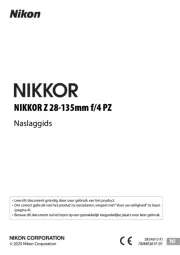
17 April 2025
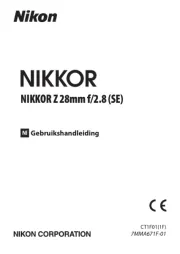
9 April 2025
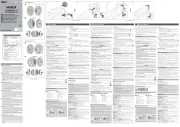
27 Maart 2025
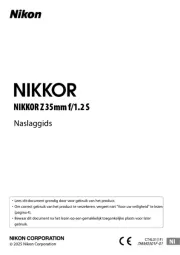
17 Maart 2025
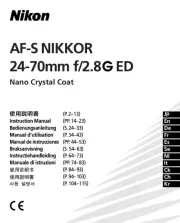
20 Februari 2025
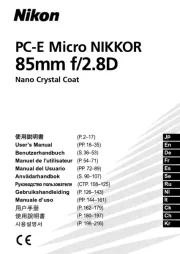
20 Februari 2025

8 December 2024
Handleiding Lens
- Fujifilm
- Celly
- Zeiss
- Lensbaby
- InLine
- Gigabyte
- Tamron
- Flir
- Hanwha
- Cambo
- Yongnuo
- Bresser
- OM SYSTEM
- Fujinon
- Monster Adapter
Nieuwste handleidingen voor Lens
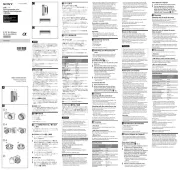
29 Juli 2025
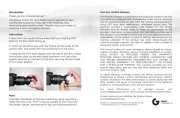
29 Juli 2025
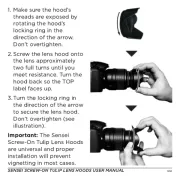
29 Juli 2025
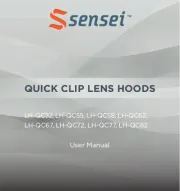
29 Juli 2025
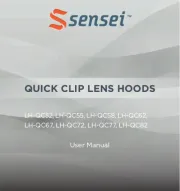
29 Juli 2025
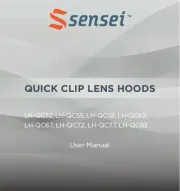
29 Juli 2025
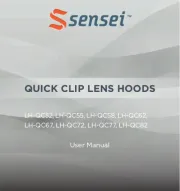
29 Juli 2025
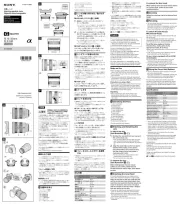
28 Juli 2025
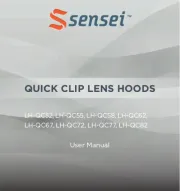
28 Juli 2025
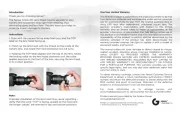
28 Juli 2025
